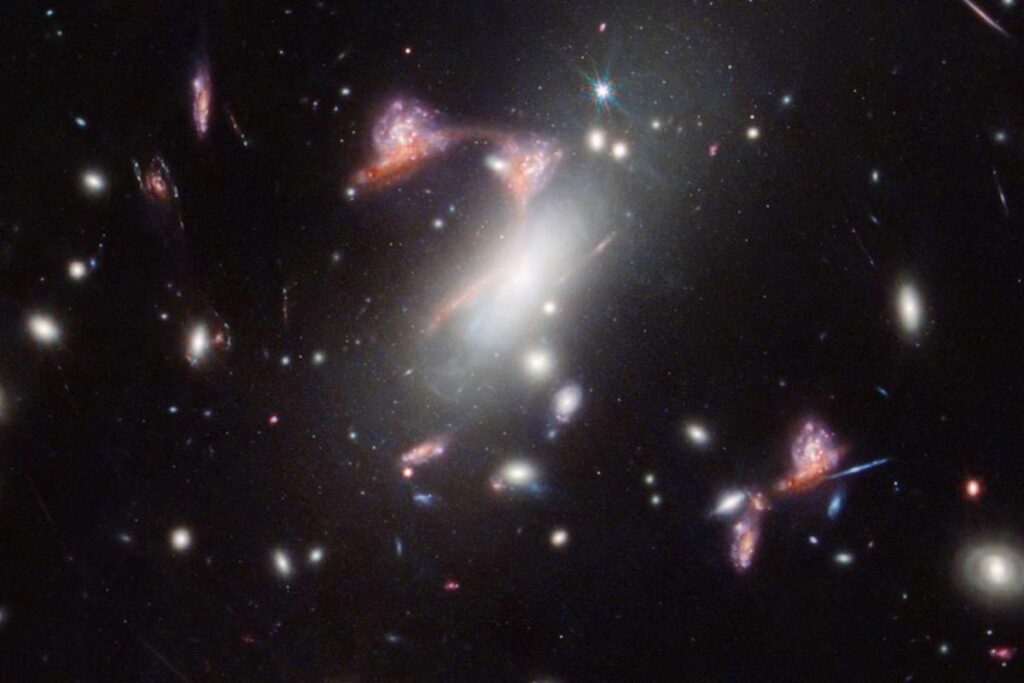Astronomers in Canada used the James Webb Space Telescope and a third time- and space-bending cluster of galaxies to create an image of two galaxies millions of light-years away.
web telescope
An image of the galaxy
NASA has captured a new image of a question mark-shaped cluster of galaxies very close to home. Astronomers say the image could potentially teach us more about the history of our own galaxy.
In a press release In a statement shared by the organization on Wednesday, September 4, researchers announced that the James Webb Space Telescope has been used to capture clearer images of two distant galaxies that form question mark shapes when paired with a third cluster of galaxies, known as MACS-J0417.5-1154.
This dusty red galaxy was previously photographed by NASA’s Hubble Space Telescopebut researchers used both the Webb and Hubble telescopes to capture new images of it. According to NASA, astronomers used MACS-J0417.5-1154 as a kind of magnifying glass, because it is so large that it distorts the fabric of space-time.
“This allows astronomers to see more detail in much more distant galaxies behind the cluster. However, the same gravitational effects that magnify the galaxies also cause distortion, resulting in galaxies that appear to be smeared across the sky in arcs and even appear multiple times,” NASA wrote in its press release. “These optical illusions in space are called gravitational lensing.”
Related: ‘Strange’ sound astronaut heard from Boeing Starliner is just a ‘common’ occurrence, NASA says
web telescope
A cosmic question mark appears amid a powerful gravitational lens in the James Webb Space Telescope’s wide-field view of the galaxy cluster MACS-J0417.5-1154
Because of these distortions, researchers said, the galaxy captured by the telescope was interacting with a spiral galaxy (also previously detected by Hubble). The “unusual” magnification and distortion of the two galaxies made it appear as if they appeared multiple times at the top of the question mark.
According to NASA, this unusual distortion is called a “hyperbolic umbilical gravitational lens” and involves “a special, rare alignment between the distant galaxies, the lens, and the observer.”
Never miss a story – sign up for PEOPLE’s free daily newsletter to stay up to date with the best that PEOPLE has to offer, from celebrity news to compelling human interest stories.
“We know of only three or four cases of similar gravitational lens “This is a special find because it shows the power of Webb and suggests that we might now find more of it,” said astronomer Guillaume Desprez, a member of the team that presented the Webb results at Saint Mary’s University in Canada.
NASA added that the dot in the question mark is an unrelated galaxy that just happens to be “in the right place and in the right spacetime, from our perspective.”
The organization noted that these images and data were acquired as part of a case study to determine how well Webb’s NIRISS (Near-Infrared Imager and Slitless Spectrograph) instrument could gather information about star formations millions of light-years away. The question mark was a “cool” addition.
Related: Starliner Capsule begins return to Earth without crew, who will remain in space?
web telescope
The Hubble image of the galaxy compared to the Webb image
“This just looks cool. Great images like this are the reason I started studying astronomy at a young age,” said lead astronomer Marcin Sawicki, also of Saint Mary’s University.
“Knowing when, where and how star formation occurs within galaxies is crucial to understanding how galaxies have evolved over the history of the universe,” adds Vicente Estrada-Carpenter, associate astronomer at St. Mary’s.
According to Estrada-Carpenter, the two galaxies discovered via MACS-J0417.5-1154 are in the early stages of interacting with each other, likely the result of a collision.
“These galaxies, seen billions of years ago when star formation was at its peak, resemble the mass that the Milky Way would have had at that time. Webb lets us study what the teenage years of our own galaxy would have looked like,” Sawicki added.
For more People news, be sure to: Sign up for our newsletter!
Read the original article at People.

